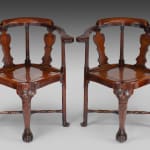Pair of Chinese Export Huang Huali or Xiang Hongmu Armchairs
33 ½ x 29 ½ x 28 in
Further images
Provenance
Richard Milhender, Boston, MassachusettsAcquired by Martyn Gregory, London from Richard Milhender
Of pegged construction, each with a curved, shaped top rail continuing to form the outswept flattened scrolling arms supported by three turned balusters, interspersed with two vase-shaped splats above a solid seat, the front cabriole shaped leg with a carved shell and a bellflower to the knee and terminating in a claw and ball foot, the three cylindrical legs ending in pad feet, tied with a baluster-turned X-frame stretcher.
The form of this chair which originated in Europe is often referred to as a corner chair. However, this is a misnomer as rather than the design allowing the chair to be placed in the corner of a room, the central front leg and the positioning of the arm supports were designed to minimise obstruction for the sitter to seat themselves at a desk or table for writing or playing cards.
This Chinese pair is based on such an English prototype. Aspects of the design such as the pegged construction and the slightly exaggerated, higher claw and ball foot mark it out as Chinese when compared with English designs.
The first record of Chinese chairs being exported to England dates from 1726 when the East India Company brought '24 Chairs of rosewood inlaid with mother of pearl' valued at £12. During the mid-18th century, China's export trade was subject to stringent regulations, allowing commerce exclusively with a select number of European nations only through the ports of Canton and Shanghai. As Carl L. Crossman explains in ‘The Decorative Arts of the China Trade: Paintings, furnishings and exotic curiosities’, such furniture may have been made to special order, perhaps for a member of the British East India Company posted in China or on Macao, another company outpost.’
Adam Bowett discusses the production of Chinese Export chairs which were made to English designs in ‘Early Georgian Furniture 1715-1740’ (Antique Collectors Club, 2009), p.47-50. He comments that, from the 1720s, the East India trade began importing ‘rosewood’ furniture made to English patterns. However, ‘[t]he precise identity of the ‘rosewood’ employed in such furniture has been the subject of much connoisseurial and botanical debate…, but the majority appears to have been made from what is now called padouk’ (ibid, p.47).










